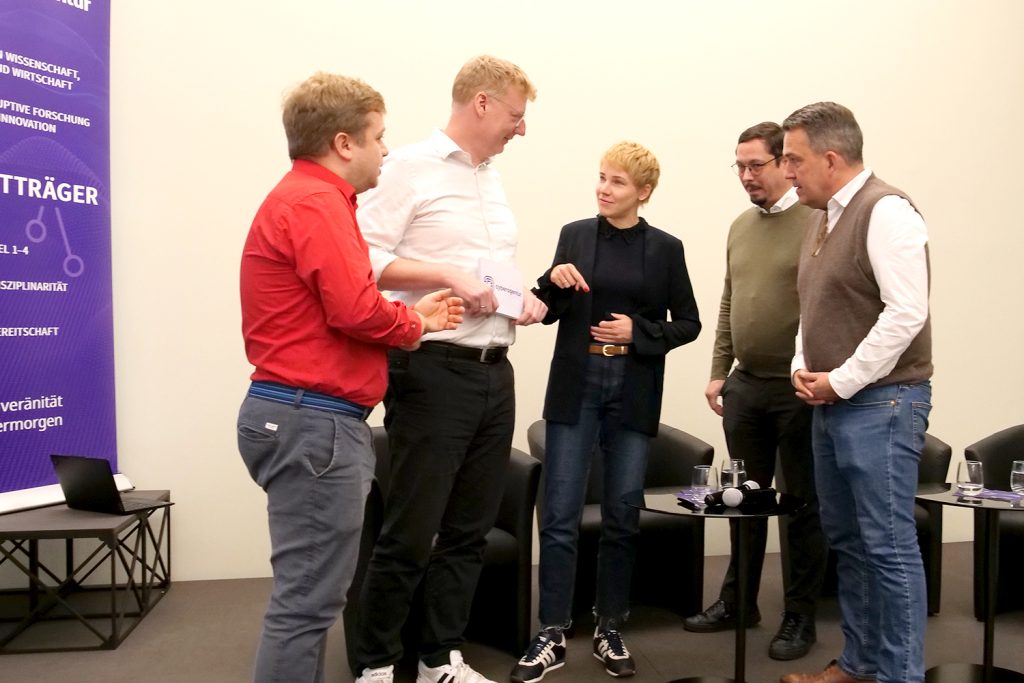Research strengthens trust – VeNIM shows ways to authenticate digital content

With the VeNIM research project, Fraunhofer AISEC and the University of Passau laid the foundation for an open trust architecture to verify the authenticity and integrity of multimedia content on behalf of the Agentur für Innovation in der Cybersicherheit GmbH (Cyberagentur). The presentation of the results on November 11, 2025 in Halle (Saale) marked the conclusion of a project that takes a decisive step towards the prevention of deepfakes and the legally compliant traceability of digital data.
In the age of AI, digital images, videos and audio files can be deceptive – and they are increasingly so. The growing number of fakes and targeted disinformation not only jeopardizes individual judgments, but also trust in the media, science and politics. VeNIM (“Trust Concept for a Sustainable Information and Media Architecture”) is the first systematic investigation into how digital content can be checked for authenticity and origin in the future.
The project, which was funded by the Cyberagentur, was completed at the end of 2024 by Fraunhofer AISEC together with the University of Passau. The aim was to develop a technical and legal trust architecture that makes the authenticity and integrity of data verifiable and at the same time protects privacy – for journalists, activists and whistleblowers, for example. The basis was the international standard C2PA (Coalition for Content Provenance and Authenticity), which was further developed in VeNIM through the C2PAExt concept.
Prof. Dr. Daniel Loebenberger, Head of the Secure Infrastructure Department at Fraunhofer AISEC, presented the results: “With C2PAExt, we are creating a system that goes beyond standards for authenticating media content. It combines cryptographic proofs, resilient watermarking and deepfake detection with a privacy-preserving provenance store. This means that in future, digital content can not only be technically verified, but also subsequently checked to see whether it has been altered or manipulated – while fully protecting the privacy of users.”
Loebenberger also outlined the practical applicability of the technologies developed: “I see a realistic realization of the concepts presented in VeNIM, especially in regulated, for example military contexts. For example, reconnaissance images that are further processed within certain systems after being captured are conceivable. Such a service contains metadata of selected media content, including change, modification or merging histories, and makes these accessible on request. In addition to simply checking whether certain content has been stored correctly in the store, it should also be possible to detect manipulation or trace which parts of the data have been combined – all strictly cryptographically secured.”
Loebenberger also emphasized the future viability of the developed architecture: “Our methods are post-quantum-resistant – so they will remain secure even if future quantum computers are able to break the encryptions that are widely used today.”
Florian Meesmann, Deputy Editor-in-Chief and Editorial Director of MDR Aktuell TV at MITTELDEUTSCHER RUNDFUNK, had previously emphasized the social importance of research in his keynote speech: “VeNIM stands for the attempt to combine journalistic, scientific and technological perspectives. Here, it is not algorithms that become the judges of truth, but cooperation and transparency that form the basis of trust.” According to Meesmann, trust is “what holds our community together – between science and the public, between the media and citizens.”
In the panel discussion that followed, it became clear that VeNIM is more than just a technical research project – it is a contribution to a “culture of trust”. Together with Florian Meesmann and Prof. Dr. Daniel Loebenberger, Caroline Lindekamp, Director CORRECTIV.Faktencheck, led by moderator Marcel Roth, discussed responsibility in dealing with new technologies and platforms as well as the limits of technical control.
“Media literacy used to be enough,” explained Florian Meesmann, “today we have to use technology to be able to check trustworthiness at all. The visionary aspect of VeNIM can be to establish trust. It shows that technology and ethics must be considered together. The resonance spaces for fake news must become smaller – that is a central task of public service media. And: transparency is the most important instrument for confidentiality.”
“We have very good information media in Germany that can be trusted,” said Caroline Lindekamp from Correctiv. “Our analyses show that people are more susceptible to disinformation when they are suspicious. Everyone is therefore responsible for what they consume.”
Questions of technological sovereignty and dependence on global platforms were also in focus: “This is precisely the challenge,” said Prof. Dr. Loebenberger, “that we are dependent on cooperation with large platforms and at the same time have to uphold digital sovereignty. Trust can only become truly systemic if these technologies are widely implemented.” Caroline Lindekamp objected: “But what about technological sovereignty vis-à-vis the large platforms?”
In the second part of the event, students from the Media and Communication Studies course at Martin Luther University Halle-Wittenberg took part in practical workshops. Led by Caroline Lindekamp and Prof. Dr. Daniel Loebenberger, they discussed AI-supported verification processes, fact checks and the role of editorial offices in times of generative AI. The students also had the opportunity to discuss deepfake detection.
Dr. Fabian Schrumpf, head of the Cyberagentur’s research project, summed up the day: “With VeNIM, we have created a resilient basis for preparing the transfer to concrete use cases in a follow-up project. The research has shown that a trustworthy digital public sphere is not a state, but a process – which we must shape together with science and the media.”
At the end of the day, there was a shared realization that trust in the digital space needs to be redefined – technologically, socially and ethically.
With a view to the Cyberagentur’s future research, VeNIM thus fits directly into the leitmotif of cyber vigilance: the ability to recognize digital threats at an early stage, create trustworthy information spaces and thus strengthen the resilience of a networked society. VeNIM provides the scientific blueprint for this.
Further information and registration:
https://cyberraum-podcast.podigee.io/11-vertrauensarchitektur (Podcast on the topic)
